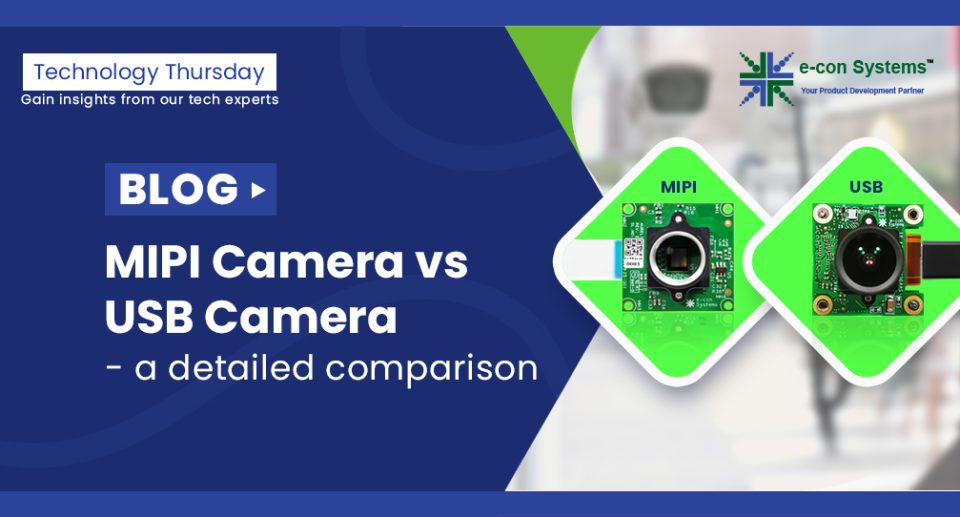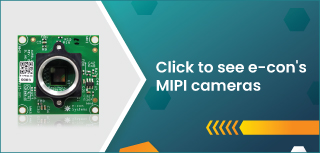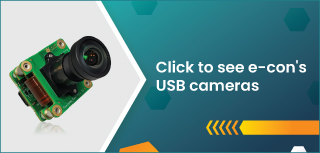Over the past few years, embedded vision has evolved from a buzzword to a widely adopted technology used across industrial, medical, retail, entertainment, and farming sectors. With each phase of its evolution, embedded vision has ensured a significant growth in the number of camera interfaces available to choose from. However, despite the technological advancements, MIPI and USB interfaces have remained the two most popular types for a majority of embedded vision applications.
The selection of a best-fit interface depends on many factors like frame rate/bandwidth requirements, resolution, data transfer reliability, cable length, complexity, and – of course – the overall cost. In this article, we look at both interfaces in detail to better understand their capabilities and limitations.
A deeper look at MIPI and USB interfaces
A MIPI camera is nothing but a camera module or system that uses a MIPI interface to transfer images from the camera to the host platform. In comparison, a USB camera uses a USB interface for data transfer. Now, let us understand the different types of MIPI and USB interfaces and where they are used.
MIPI Interface
MIPI is the most commonly used interface in today’s market for point-to-point image and video transmission between cameras and host devices. It can be attributed to MIPI’s ease of use and its ability to support a broad range of high-performance applications. It also comes equipped with powerful features such as 1080p, 4K, 8K and beyond video and high-resolution imaging.
MIPI interface is an ideal choice for applications like head-mounted virtual reality devices, smart traffic applications, gesture recognition systems, drones, facial recognition, security, surveillance systems, etc.
MIPI CSI-2 Interface
The MIPI CSI-2 (MIPI Camera Serial Interface 2nd Generation) standard is a high-performance, cost-effective, and simple-to-use interface. MIPI CSI-2 offers a maximum bandwidth of 10 Gb/s with four image data lanes – each lane capable of transferring data up to 2.5 Gb/s. MIPI CSI-2 is faster than USB 3.0 and has a reliable protocol to handle video from 1080p to 8K and beyond. In addition, owing to its low overhead, MIPI CSI-2 has a higher net image bandwidth.
The MIPI CSI-2 interface uses fewer resources from the CPU – thanks to its multi-core processors. It is the default camera interface for Raspberry Pi and Jetson Nano. The Raspberry Pi camera module V1 and V2 are also based on it.
Limitations of MIPI CSI-2 Interface
Even though it is a powerful and popular interface, MIPI CSI does come with a few limitations. For instance, MIPI cameras rely on extra drivers to work. It means that there is limited support for different image sensors unless embedded system manufacturers really push for it!
To learn more about MIPI cameras and how they work, have a look at What is a MIPI camera? How does MIPI camera work?
USB Interface
The USB interface tends to serve as the junction between two systems – the camera and the PC. Since it is well-known for its plug-and-play capabilities, choosing the USB interface implies that you can say goodbye to expensive, drawn-out development times and costs for your embedded vision interface. USB 2.0, the older version, has significant technical limitations. As the technology begins to dwindle, a number of its components become incompatible. USB 3.0 and the USB 3.1 Gen 1 interfaces were launched to overcome the limitations of the USB 2.0 Interface.
USB 3.0 Interface
The USB 3.0 (and USB 3.1 Gen 1) interface combines the positive features of different interfaces. These include plug-and-play compatibility and low CPU load. The vision industrial standard of USB 3.0 also increases its reliability for high-resolution and high-speed cameras.
It requires minimal additional hardware and supports low bandwidth – up to 40 megabytes per second. It has a maximum bandwidth of 480 megabytes per second. This is 10 times faster than USB 2.0 and 4 times faster than GigE! Its plug-and-play capabilities ensure that embedded vision devices can be swapped out with ease – making it easy to replace a damaged camera.
Limitations of USB 3.0 Interface
The biggest disadvantage of the USB 3.0 interface is that you cannot run high-resolution sensors at high speed. Another downfall is that you can only use a cable up to a distance of 5 meters from the host processor. While longer cables are available, they are all fitted with “boosters”. How well these cables work together with industrial cameras has to be checked for every individual case.
MIPI Camera vs USB Camera – a feature by feature comparison
Now that we understand what each of the two interfaces is, let us do a feature by feature comparison of MIPI and USB in the below table:
| Features | USB 3.0 | MIPI CSI-2 |
| Availability on SoC | On high -end SoCs | Many (Typically 6 lanes available) |
| Bandwidth | 400 MB/s | 320 MB/s/lane 1280 MB/s (with 4 lanes)* |
| Cable Length | < 5 meters | <30 cm |
| Space Requirements | High | Low |
| Plug-and-play | Supported | Not supported |
| Development Costs | Low | Medium to High |
- – Max bandwidth with MIPI-CSI2 / MIPI D-PHY® v1.2 used in NVIDIA Jetson AGX Xavier Platform
GMSL is another popular interface which is used as an alternative to MIPI and USB, typically when the image data has to be transferred to a distance of more than 3 meters. To understand how a MIPI camera compares with GMSL camera, check out GMSL camera over MIPI camera.
To learn how to choose an interface for your embedded vision system, visit How to choose the right interface for an embedded vision system.
Related Cameras
Conclusion
A camera interface represents a make or break moment for embedded vision applications. Hence, picking the right interface between MIPI and USB is a crucial decision. Even though there are some embedded vision applications where neither MIPI nor USB will be a fit, in majority of the cases one of them will suffice. Choosing the best fit interface will depend on the feature set required by your embedded device.

Prabu is the Chief Technology Officer and Head of Camera Products at e-con Systems, and comes with a rich experience of more than 15 years in the embedded vision space. He brings to the table a deep knowledge in USB cameras, embedded vision cameras, vision algorithms and FPGAs. He has built 50+ camera solutions spanning various domains such as medical, industrial, agriculture, retail, biometrics, and more. He also comes with expertise in device driver development and BSP development. Currently, Prabu’s focus is to build smart camera solutions that power new age AI based applications.




